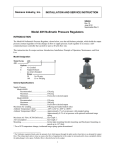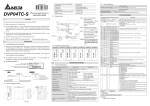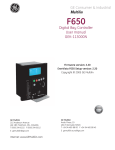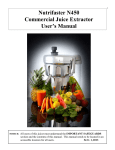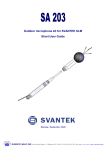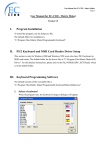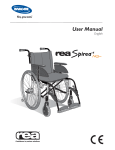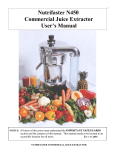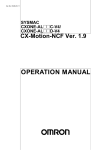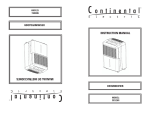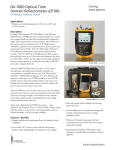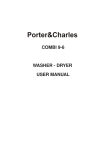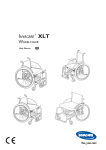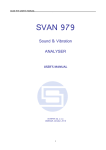Download Model 40 Nullmatic Pressure Regulators
Transcript
Siemens Industry, Inc. INSTALLATION AND SERVICE INSTRUCTION SD40 Rev 17 June 2012 Supersedes Rev 16 Model 40 Nullmatic Pressure Regulators INTRODUCTION The Model 40 Nullmatic® Pressure Regulator, shown below, uses the null-balance principle, which holds the output pressure constant regardless of wide changes in flow or supply pressure. Each regulator is in essence a selfcontained pressure controller. This instruction has five major sections: Introduction, Installation, Principle of Operation, Maintenance, and Parts List. Model Designation Model Series 40 Options A Air Loaded E Tapped Exhaust X Without safety release (ranges 2, 7, 15, 30, and 50 only) (no letter) Standard Range 2 1"H2O to 50"H2O 7 6"H2O to 200"H2O 15 0.5 to 15 psig 30 1 to 30 psig 50 1 to 50 psig 100 1.5 to 100 psig 200 3 to 200 psig 300 7 to 300 psig 450 15 to 450 psig 40 A 15 Sample Model Number General Specifications Model Number 40-2 40-7 40-15 40-30 40-50 40-100 40-200 Range in PSIG(1) 0.1 to 2(3) 0.25 to 7(4) 0.5 to 15 1 to 30 1 to 50 1.5 to 100 3 to 200 40-300 40-450 7 to 300 15 to 450 Supply Pressure (PSIG) Recommended Maximum Minimum(2) 10 25 5 psi above highest output setting to be 50 100 used 75 150 120 150 10 psi above highest output 120 150 setting to be used 150 500 250 500 20 psi above highest output 350 500 setting to be used 500 500 1 Notes (1) Range limits with recommended supply. (2) Minimum supply value for Regulator operation. Performance will be improved by increasing the supply pressure above the minimum value. (3) 1"H2O to 50"H2O. (4) 6"H2O to 200"H2O. SD40 Maximum air loading pressure (air loaded models) ........... 100 psig Ambient temperature limits ...........................-40°F to 180°F (-40°C to 82°C) Flow Capacity................................................See Figure 1 Air Capacity...................................................See Figure 2 1 Figure 1 Maximum Air Flow, SCFM Delivered Figure 2 Air Consumption INSTALLATION Mounting Considerations Refer to Figure 3 for mounting dimensions. The regulator may be mounted in any position in a reasonably vibrationfree location. Regulators are intended for panel mounting on panels of 1/4" maximum thickness. If wall mounting is desired, order Mounting Bracket part number 2932-19 and install as shown in Figure 3. CAUTION Exceeding the ambient air temperature limits can adversely affect performance and may cause damage. Pneumatic Connections All connections are 1/4" (except for the optional tapped exhaust connection) as shown in Figure 3. Recommended piping to the regulator is 1/4" O.D. tubing, although any scale free piping may be used. 1. Blow out all piping before any connections are made to prevent dirt or chips from entering the regulator. 2. Use pipe sealant sparingly, and then only on the male threads. A non-hardening sealant is strongly recommended. 3. Connect the regulator to a source of clean, dry, oil-free instrument air. See Instrument Air Requirements. CAUTION Pressure in excess of the maximum value, listed in General Specifications, to the supply or air loading connection may cause damage. 1 The Nullmatic regulator bleeds only the amount of air which passes through the pilot nozzle when there is no demand for output flow. The exhaust port starts to close as soon as the flow of regulated air to the output is increased and it closes completely before the pilot-plunger valve opens. Full pilot flow is then delivered to the output. 2 SD40 Figure 3 Dimensions and Mounting Table 1 Metric Conversions Inches 1/64 1/32 1/8 3/16 1/4 9/32 7/16 1/2 25/32 Millimeter 0.3 0.7 3.1 4.7 6.3 7.1 11.1 12.7 19.8 Metric Conversions Inches Millimeters 7/8 22.2 1-3/8 34.9 1-11/16 42.8 2 50.8 2-1/8 53.9 2-1/4 57.1 2-3/8 60.3 2-13/16 71.4 2-7/8 73.0 3 Inches 2-15/16 3-1/8 3-1/4 3-3/8 3-3/4 4-3/8 5-3/16 Millimeters 74.6 79.3 82.5 85.7 95.2 111.1 131/7 SD40 INSTRUMENT AIR REQUIREMENTS Connect the regulator to a source of clean, dry, oil-free instrument air. Failure to do so will increase the possibility of a malfunction or deviation from specified performance. CAUTION Use of process fluids other than instrument air is not recommended. No claim is made as to the suitability of this product for use with other process fluids, such as hazardous gases, except as listed on the appropriate certificate. Non-approved instruments are suitable for use with instrument air only. Optional features and modifications such as tapped exhaust do not imply suitability for use with hazardous gases except as listed on the approval certificate. CAUTION Synthetic compressor lubricants in the air stream at the regulator may cause the regulator to fail. There are many types of synthetic lubricants. Some may not be compatible with the materials used in construction of the regulator. Wetting of these materials by such an oil mist or vapor, etc.; may cause them to deteriorate. This may ultimately result in failure of the regulator. The following materials are in contact with instrument air: Aluminum, Brass, Neoprene, Nitrile, Nylon and Stainless Steel. The requirements for a quality instrument air supply can be found in the Instrument Society of America's "Quality Standard for Instrument Air" (ISA-S7.3). Basically this standard calls for the following: Particle Size - The maximum particle size in the air stream at the instrument should be no larger than 3 microns. Dew Point - The dew point, at line pressure, should be at least 10° C (18° F) below the minimum temperature to which any part of the instrument air system is exposed at any season of the year. Under no circumstances should the dew point, at line pressure, exceed 2° C (35.6° F). Oil Content - The maximum total oil or hydrocarbon content, exclusive of non-condensables, should not exceed 1 ppm under normal operating conditions. PRINCIPLE OF OPERATION A fine-turn, precision screw is used to manually load the range spring which sets the regulated pressure. When the adjusting knob, see Figure 4, is turned clockwise, the increased spring force is exerted on the top diaphragm assembly which decreases the nozzle clearance and increases the pilot pressure. The source for pilot pressure is supply air flowing to the pilot pressure chamber through the restriction screw. The increased pilot pressure forces the exhaust diaphragm assembly downward, closing the exhaust port, contacting and moving the valve plunger and thereby opening the supply port. This increases the regulated output which also feeds back to the top diaphragm assembly. The regulator locks-up or throttles at the new output value when the feedback force of the top diaphragm assembly equals the range spring force. A safety release valve is incorporated in the top diaphragm assembly of the -2 through -50 models. The safety release operates if the regulated pressure becomes 3 to 5 psig more than the set pressure. It exhausts air through the atmospheric vent in the top housing. An over-pressure causes the diaphragm to move upward, opening the safety release valve when the valve motion is stopped by the stripper plate. 4 SD40 Figure 4 Schematic MAINTENANCE Most problems associated with pneumatic instruments can be prevented by providing clean, dry, oil-free instrument quality air as described in Installation, Instrument Air Requirements. No routine maintenance procedures are recommended if these requirements are observed. Lubricating the Adjusting Screw An occasional application of light grease to the adjusting screw threads will facilitate easy turning of the adjusting knob, especially in the high-pressure models. Cleaning the Restriction Screw 1. Turn off the supply air. 2. Remove restriction screw from bottom forging. 3. Remove the knurled cleaning wire located near the output port and run it through the orifice at the tip of the restriction screw. In stubborn cases, the screw can be soaked in solvent to dissolve the blockage. Examine the O-ring for damage and cleanliness. 4. Re-install the screw and tighten it securely. Cleaning the Valve Plunger 1. Turn off supply air. 2. Carefully remove retaining nut on bottom forging. The valve plunger and plunger spring will drop out when this nut is removed; be careful not to lose them. The valve plunger must be clean on both the ball and tapered-end surfaces. If necessary, use a non-abrasive solvent. 3. Clean supply and exhaust seats in the regulator. The supply seat is readily accessible; the exhaust seat can be reached using a tobacco pipe cleaner. Here again, use non-abrasive solvents. 4. Re-install parts; see the parts list for part orientation. Tighten the retaining nut securely. Troubleshooting Refer to Table 2 on the next page to troubleshoot the regulator. 5 SD40 Table 2 Model 40 Troubleshooting SYMPTOM No output Output cannot be increased to full value Sluggish output response to increased setting Output at full valve, or more, and cannot be decreased Output cannot be deceased to minimum value CAUSE No air supply Clogged restriction screw Supply air setting too low Valve plunger being held open on exhaust seat by a chip (pipe scale, etc.) usually detected by a heavy exhaust Clogged restriction screw Output flow excessive for air supply setting Output flow exceeds specification Partially clogged restriction screw Regulator piped backwards. Detected by an excessively heavy exhaust. Loose restriction screw External exhaust port blocked Internal exhaust port clogged Supply pressure too high Loose restriction screw Valve plunger being held open on exhaust seat by a chip (pipe dope, Teflon tape, thread shaving, pipe scale, etc.) Heavy carbon or carbon/oil build-up on nozzle seat Damaged supply seat REMEDY Turn on supply air Remove and clean Raise to recommended value Remove valve plunger and clean its seats. Remove and clean Raise supply pressure Consult factory Remove and clean Re-pipe the regulator. Direction of flow is shown by arrow on bottom forging. Tighten securely Remove obstruction Remove valve plunger and clean exhaust seat port. Reduce to recommended value Tighten securely Remove valve plunger and clean its seats. Disassembly regulator and clean exhaust seat. Install new bottom forging Disassembling the Regulator Before disassembling, back-off the adjusting knob to relieve spring tension. Also, make a diagonal mark across all mating parts to provide easier alignment of parts during reassembly. To disassemble the regulator, refer to the parts list drawings for part location and remove the body screws. Assembling the Regulator The exhaust diaphragm assembly and exhaust ring must be positioned so that none of the holes on the bottom forging are blocked. The three external holes on the exhaust ring line up under the gauge connection – see Figure 3 for orientation with respect to the supply and output ports. The center housing must be positioned to allow pilot and rebalance air to flow to the proper chambers: pilot air to the bottom cavity of the center housing, and rebalance air to the top cavity. See Figure 3 for orientation of the gauge connection with respect to the supply and output ports. The nozzle seat assembly must be installed with its smooth finish seat facing down to the nozzle. The safety release valve (where applicable) must be positioned on the nozzle seat assembly before the stripper plate is installed. Center the nozzle seat assembly over the nozzle before tightening its retaining screws. The top diaphragm assembly and the top casting can be located in any position. Generally, the nameplate on the casting lines up over the gauge connection. 6 SD40 Changing the Range The range of any Model 40 regulator may be changed by replacing the range spring, differential spring, the upper diaphragm assembly, and other parts as noted in the parts list. Replacing Parts Refer to the parts list(s) at the back of this instruction when performing maintenance on a Model 40. A parts list provides a list of replacement parts and an exploded view of the regulator. Service kits containing spare and replacement parts are available from Siemens. See the Customer/Product Support section to contact Siemens. Refer to the Parts List section for kits and recommended on-hand spare parts. Customer/Product Support This section provides the Siemens public Internet site address, e-mail address, telephone numbers, and related information for customers to access Siemens product support. When contacting Siemens for support: • • Please have complete product information at hand: • For hardware, this information is provided on the product nameplate (part number or model number, serial number, and/or version). • For most software, this information is given in the Help > About screen. If there is a problem with product operation: • Is the problem intermittent or repeatable? What symptoms have been observed? • What steps, configuration changes, loop modifications, etc. were performed before the problem occurred? • What status messages, error messages, or LED indications are displayed? • What troubleshooting steps have been performed? • Is the installation environment (e.g. temperature, humidity) within the product’s specified operating parameters? For software, does the PC meet or exceed the minimum requirements (e.g. processor, memory, operating system)? • A current copy of the product Service Instruction, User’s Manual, or other technical literature should be at hand. The Siemens public Internet site (see the table) has current revisions of technical literature, in Portable Document Format, for downloading. • To send an instrument to Siemens for repair, request a Return Material Authorization (RMA). IMPORTANT An instrument must be thoroughly cleaned (decontaminated) to remove any process materials, hazardous materials, or blood born pathogens prior to return for repair. Read and complete the Siemens RMA form(s). 7 SD40 For support and the location of your local Siemens representative, refer to the table below for the URL of the Process Instrumentation (PI) portion of the Siemens public Internet site. Once at the site, click Support in the right column and then Product Support. Next select the type of support desired: sales, technical (see the table below), documentation, or software. Online Support Request http://www.siemens.com/automation/support-request Technical Support 1-800-333-7421; 8 a.m. to 4:45 p.m. eastern time, Monday through Friday (except holidays) Customer Service & Returns 1-800-365-8766 (warranty and non-warranty) Public Internet Site http://www.usa.siemens.com/pi Technical Publications in PDF Click the above link to go to the Siemens Internet site and then click Process Instrumentation. In the column to the right, click Support > Manuals. In the column to the left, select the product line (e.g. Pressure or Temperature or Controllers) to open navigation and search panes. Note: Navigation may change as the site evolves. Warranty The sales contract contains the entire obligation of Siemens. The warranty contained in the contract between the parties is the sole warranty of Siemens. Any statements continued herein do not create new warranties or modify the existing warranty. Nullmatic is a registered trademark of Siemens Industry, Inc. All product designations may be trademarks or product names of Siemens Industry, Inc. or other supplier companies whose use by third parties for their own purposes could violate the rights of the owners. Siemens Industry, Inc. assumes no liability for errors or omissions in this document or for the application and use of information in this document. The information herein is subject to change without notice. Procedures in this document have been reviewed for compliance with applicable approval agency requirements and are considered sound practice. Neither Siemens Industry, Inc. nor these agencies are responsible for product uses not included in the approval certification(s) or for repairs or modifications made by the user. 8 SD40 PARTS LIST Siemens Nullmatic® Pressure Regulator, Models 40, 40A, and 40X Drawing 2155-51PL 1/96 Supersedes 12/87 IMPORTANT Service Parts Kits are available for servicing the instrument. See the Service Parts Kits section of this instruction. Contact Siemens for currently available kits; refer to the Product Support section of this instruction. Some parts in this Parts List may not be available for separate purchase. 9 SD40 10 SD40 PARTS LIST Siemens Nullmatic® Pressure Regulator, Models 40E and 40AE Drawing 3827PL 1/96 Supersedes 12/87 IMPORTANT Service Parts Kits are available for servicing the instrument. See the Service Parts Kits section of this instruction. Contact Siemens for currently available kits; refer to the Customer/Product Support section of this instruction. Some parts in this Parts List may not be available for separate purchase. 11 SD40 12 SD40 SERVICE PARTS KITS Listed below are the kits available at the time of publication of this instruction. Order the kit(s) needed to service the regulator model at hand. In addition to the parts listed, some kits include a parts list drawing or other instructions. For Model(s), Kit Name, Part Number All, Valve Plunger Kit, 2155-272 Kit Contents Plunger Plunger Spring 40H50, Diaphragm/Misc. Parts Kit, 7298-100 Diaphragm Top Diaphragm Assembly O-ring Diaphragm Assembly 40HPlunger Assembly 1 1 1 1 1 40H100, Diaphragm/Misc. Parts Kit, 7298-101 Diaphragm Top Diaphragm Assembly O-ring Diaphragm Assembly 40HPlunger Assembly 1 1 1 1 1 40 (X/A/E), Spare Parts Kit, 7298-102 Cleaning Wire Retaining Screw Pilot Screen Restriction Screw 2 2 2 2 40-2/7/15/30/50, Diaphragm/SR Kit, 7298-103 Bottom Diaphragm Assembly Top Diaphragm Assembly Safety Release Assembly 1 1 1 40E2/7/15/30/50, Diaphragm Kit, 7298-104 Top Diaphragm Assembly Diaphragm Assembly 1 1 40A2/7/15/30/50, Diaphragm/O-ring Kit, 7298-105 Bottom Diaphragm Assembly Top Diaphragm Assembly O-ring 1 1 1 40-100 (X/A), Diaphragm/Gasket Kit, 7298-106 Diaphragm Top Diaphragm Assembly O-ring Gasket 1 1 1 1 40-100 (E), Diaphragm/Gasket Kit, 7298-107 Diaphragm Assembly Top Diaphragm Assembly 1 1 40-200/300(X/A), Diaphragm/Gasket Kit, 7298-108 Diaphragm O-ring Diaphragm Assembly Gasket 1 1 1 1 40AE/E200/300, Diaphragm/Gasket Kit, 7298-109 Diaphragm Assembly O-ring Gasket 2 1 1 13 Quantity 1 1 SD40 For Model(s), Kit Name, Part Number Kit Contents 40-450 (X/A), Diaphragm/Gasket Kit, 7298-110 Diaphragm O-ring Gasket 2 1 1 40-450 (E), Diaphragm/Gasket Kit, 7298-111 Diaphragm Assembly O-ring Gasket 2 1 1 All, Range Spring Kit (2, 7, 15, 30, & 50 psi), 7298-112 Range Spring (Qty 3 of each) 15 All, Range Spring Kit (100 psi & greater), 7298-113 Range Spring (Qty 4 of each) 8 40H100, Minimum Overhaul Kit, 7298-114 Restriction Screw Diaphragm Top Diaphragm Assembly O-ring O-ring Diaphragm Spacer Diaphragm Assembly, Model 40H- 1 1 1 1 1 1 1 All, Adjusting Knob Assembly, 1447-22 All, Top Casing, 4557-11 All, Bushing, 3494-4 All, Bottom Forging, 10803-36 40-2, Locknut, 1447-41 All, Range Spring (White 2 psi), 1938-1 All, Range Spring (Gray 7 psi), 2155-67 All, Range Spring (Blue 15 psi), 572-37 All, Range Spring (Red 30 psi), 572-36 All, Range Spring (Brown 50 psi), 2155-22 All, Range Spring (Green 100, 300, & 450 psi), 2155-23 All, Range Spring (Black 200 psi), 2155-90 ------------------------- 1 1 1 1 1 1 1 1 1 1 1 1 14 Quantity














